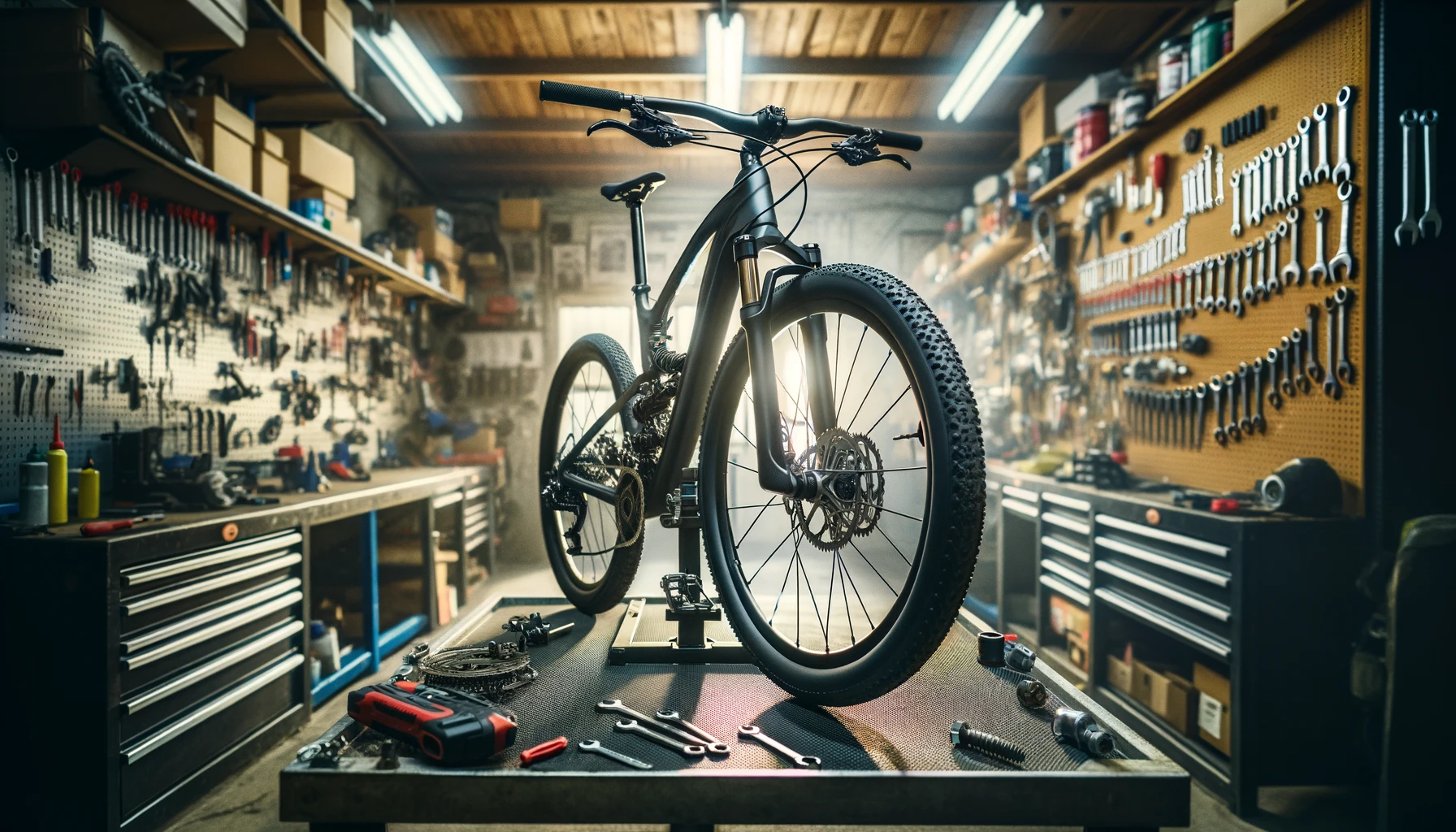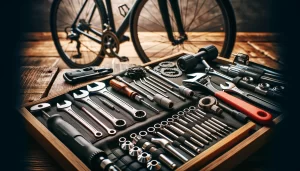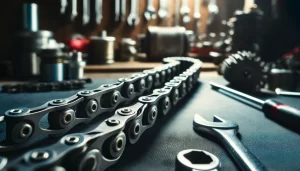The unmistakable screech of a V-brake not only disrupts the peacefulness of a bike ride but can also indicate underlying issues needing immediate attention.
If you’ve ever found yourself wincing at the high-pitched soundtrack accompanying every stop, you know the urgency of addressing this common annoyance. Fortunately, eliminating noise from your V-brakes is often simpler than many cyclists think, and with a few tweaks, you can enjoy a quieter, more serene cycling experience.
In this article, we delve into practical tips that will not only quiet your V-brakes but also enhance their performance and longevity. Whether you’re a daily commuter or a weekend trail enthusiast, these insights will equip you with the knowledge to handle brake noise like a pro.
Stick with us as we explore how minor adjustments can lead to major improvements in your ride’s braking system, ensuring safety and silence on all your cycling adventures.

Image Source: Image Generated With DALL-E on ChatGPT
Common Causes of Noise in V-Brake Systems
V-brake systems are popular in bicycles for their simplicity and effectiveness. However, they can sometimes produce annoying noises. Common causes include misaligned brake pads that contact the rim improperly, dirty or wet rims that reduce friction unevenly, and worn-out brake pads that create uneven surfaces.
Additionally, loose components can vibrate when braking. Proper maintenance and regular cleaning can significantly reduce these noises, ensuring a smoother and quieter ride.
Steps to Identify Common Causes of Noise in V-Brake Systems:
- Inspect Brake Pads: Check for uneven wear and alignment issues.
- Clean the Rims: Remove dirt, grime, and debris from the rim surfaces.
- Check for Loose Parts: Tighten any loose nuts and bolts in the brake system.
- Listen While Braking: Identify if the noise occurs at specific times or in certain conditions.
- Replace Worn Components: If issues persist, consider replacing the brake pads or cables.
How to Identify Wear in V-Brake Components
Identifying wear in V-brake components is crucial for maintaining optimal braking performance. Common signs of wear include thinning or unevenly worn brake pads, frayed or rusty brake cables, and worn or bent brake arms.
Regular inspections can prevent accidents and ensure effective braking. Look for any visible signs of damage or wear, and test the brake’s responsiveness regularly. Replacing worn components promptly can save both time and money in the long run.
Tips for Identifying Wear in V-Brake Components:
- Examine Brake Pads: Check for thinning, cracks, or uneven wear patterns.
- Inspect Brake Cables: Look for fraying or rust which can impair function.
- Test Brake Response: Apply brakes to check for any delays or inconsistencies in response.
- Look at Brake Arms: Ensure they are not bent or damaged.
- Regular Maintenance: Schedule regular checks to catch wear early and replace parts as needed.
How to Properly Adjust V-Brake Systems
Proper adjustment of V-brake systems is essential for effective braking and safety. This involves setting the brake pads at the correct distance from the rim and ensuring they are parallel to it.
The brake cables should be tensioned appropriately to allow responsive braking without being too tight or too slack. Additionally, the brake arms must be symmetrical and move evenly when applied. Regular adjustments will help maintain optimal performance and prolong the life of the brake components.
Steps to Properly Adjust V-Brake Systems:
- Align Brake Pads: Adjust so they are parallel to the rim and not touching it when the brake is released.
- Set Pad Clearance: Ensure there is a small, even gap between the pads and the rim.
- Adjust Cable Tension: Tighten or loosen the brake cable to achieve responsive braking.
- Test Brake Levers: Ensure levers are not too loose or too tight and adjust accordingly.
- Check for Symmetry: Make sure both brake arms are even and move simultaneously when applied.
The Importance of Regular Cleaning of V-Brake Systems
Regular cleaning of V-brake systems is crucial for maintaining braking efficiency and extending the life of the components. Dirt, mud, and grime can build up on the brake pads and rims, reducing the friction necessary for effective braking.
This buildup can also lead to increased wear and tear on both the pads and the rims. Regularly cleaning the brake system not only improves performance but also prevents premature wear, ensuring that the brakes remain reliable and safe.
Tips for Regular Cleaning of V-Brake Systems:
- Clean Brake Pads and Rims: Use a damp cloth or a specialized bike cleaner to remove dirt and residue.
- Inspect Pads for Wear: Clean pads will help you better inspect for any signs of wear or damage.
- Wipe Down Brake Arms: Keep the mechanical parts clean to prevent rust and ensure smooth operation.
- Lubricate Moving Parts: Apply bicycle-specific lubricant to pivot points and the brake lever mechanism.
- Regular Check-Ups: Incorporate cleaning into your regular bike maintenance routine to keep brakes in top condition.
The Role of Lubrication in Maintaining V-Brake Systems
Lubrication plays a critical role in the maintenance of V-brake systems, primarily by ensuring that all moving parts operate smoothly and without excessive wear. The brake lever mechanisms, cable housings, and pivot points of the brake arms are areas where lubrication is crucial. Proper lubrication prevents rust and corrosion caused by exposure to moisture and road salts.
Additionally, it reduces friction between moving parts, which can otherwise lead to noise and decreased performance. The choice of lubricant is also important; a light, water-resistant oil or a specific brake lubricant is recommended to provide lasting protection without attracting dirt and grime.
Continual attention to lubrication extends the life of the brake components and enhances the overall performance of the braking system. It’s essential not only to apply lubricant but also to clean off any excess that could attract dirt, which can become abrasive and cause further wear.
Regular checks and reapplication according to the riding conditions—more frequently in wet or dirty environments—are necessary to maintain the effectiveness of the brakes. By keeping the V-brake system well-lubricated, cyclists can enjoy a smoother ride with reliable and responsive braking capabilities.

Image Source: Image Generated With DALL-E on ChatGPT
Best Practice Tips for Maintaining a Quiet V-Brake
Maintaining a quiet V-brake involves several best practices that focus on proper installation, regular maintenance, and timely replacement of worn components. The first step towards a noise-free brake experience starts with ensuring that the brake pads are correctly aligned to the rim; they should be parallel and make contact with the rim evenly across their entire surface.
Misalignment can cause squeaking and uneven wear, leading to further noise and reduced braking efficiency. It’s also crucial to choose high-quality brake pads that are suited to the type of rim, as certain materials can interact better and more quietly than others.
Regular cleaning and adjustment are equally important. Dirt, debris, and residues on the rim or brake pads can cause screeching during braking. A clean and dry rim surface, along with clean brake pads, significantly reduces the chances of noisy brakes.
Additionally, checking for any loose components and ensuring all fittings are tight can prevent rattling sounds that occur when parts vibrate during braking. Adopting these maintenance practices not only promotes a quieter ride but also enhances the safety and durability of the braking system, making each cycling session more enjoyable and worry-free.
Common Questions About Noise in V-Brake Systems
Why do my V-brakes squeak when I apply them? Squeaking in V-brakes is often caused by the brake pads being misaligned or the rim being dirty or wet. It can also occur if the brake pads are worn out or if the material of the pads is incompatible with the rim material.
What can I do to stop my V-brakes from making noise? Ensuring that your brake pads are properly aligned, clean, and not excessively worn is the first step. Additionally, applying a thin layer of brake-specific lubricant to the pivot points of the brake arms can reduce friction and noise.
Is it normal for new brake pads to make noise? Yes, new brake pads can sometimes make noise initially as they bed in. However, persistent noise beyond the initial break-in period may indicate that the pads are not compatible with the rim’s material or that they need to be realigned.
Can loose components cause noise in V-brake systems? Absolutely. Loose parts, such as the brake arms, mounting bolts, or even the cable, can vibrate when the brakes are applied, leading to noise. Tightening these components can often resolve the issue.
Experiencing noise in V-brake systems can be distracting and diminish the joy of cycling. It’s a common issue that many cyclists face but one that can usually be resolved with a few simple adjustments.
Proper alignment and maintenance of the brake pads, along with keeping the rims clean, are fundamental steps in ensuring your brakes operate quietly and effectively. It’s also worthwhile to periodically check and tighten any components that could contribute to noise when loosened.
Moreover, choosing the right brake pads for the specific type of rim you have can make a significant difference in reducing brake noise. Different materials interact differently, and finding a compatible match can greatly enhance your braking experience. Regular maintenance checks, alignment, and cleaning can extend the life of your brakes and keep your rides peaceful and enjoyable.
Did you like the article? Be sure to check out more content like this in the Maintenance Guide category or see more related content below.






